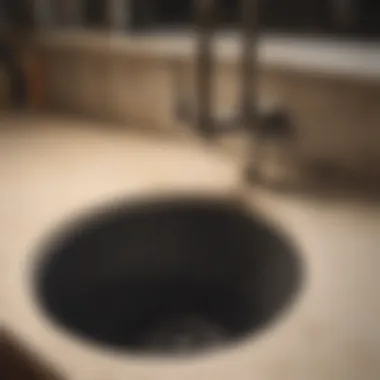Effective Solutions for Slow Kitchen Drains


Intro
Kitchen drains can frequently present challenges, affecting the efficiency of any home's plumbing system. When equipped with garbage disposals, the issue of slow drainage can be particularly prevalent. Understanding the connection between these appliances and drain issues becomes crucial for homeowners. Factors such as food waste accumulation, grease build-up, and improper use of disposals can all contribute to this problem.
In this article, we will explore the general causes of slow kitchen drains, practical troubleshooting steps, maintenance strategies, and when it may be necessary to involve professional assistance. A clear comprehension of how kitchen drainage works and how garbage disposals fit into that system can help you effectively manage and even prevent plumbing problems.
Understanding the Functionality of Garbage Disposals
Garbage disposals are designed to shred food waste into smaller pieces, facilitating easier disposal through the plumbing system. Their function, however, heavily depends on proper usage and maintenance.
Common Issues with Garbage Disposals
- Clogs: Overuse of the garbage disposal can lead to clogs, particularly if inappropriate materials are introduced. Items like fibrous vegetables, grease, or large food portions can obstruct the pipes.
- Stagnant Water: A slow-draining sink often indicates waste buildup that restricts normal flow. Additionally, a malfunctioning disposal unit can also trap water, leading to stagnant conditions.
- Overheating: Running a garbage disposal for too long can cause it to overheat, resulting in a thermal overload. This may necessitate a reset or could lead to permanent failure of the unit.
Practical Troubleshooting Steps
Identifying the cause of a slow drain is essential. Here are some practical steps to diagnose and potentially resolve the issue:
- Inspect the Disposal: First, check the garbage disposal for any visible blockage. Ensure it is turned off before doing this.
- Clear Debris: Remove any food particles or debris that may be lodged inside the disposal.
- Use Water Wisely: Run cold water while using the disposal. This helps move food waste through the system more efficiently.
- Reset the Disposal: If the unit is jammed or has stopped working, resetting it by pressing the reset button may restore functionality.
- Check for Leaks: Inspect the pipes for leaks that could contribute to slow drainage. Any signs of leaks may require tightening or replacing connections.
Maintenance Strategies
Proper maintenance plays a crucial role in preventing slow drains:
- Regular Use: Frequent use of the disposal can prevent waste from sitting too long, reducing chances of buildup.
- Suitable Waste Disposal: Avoid putting non-biodegradable items down the disposal. Stick to small food scraps and organic waste.
- Cleaning: Periodically clean the disposal by grinding ice cubes and citrus peels, which can help eliminate odors and remove residue.
- Professional Inspections: Schedule routine plumbing inspections to ensure that both the disposal and associated pipes remain in good condition.
When to Seek Professional Assistance
If all troubleshooting steps fail, it may be time to involve a professional. Persistent slow drains, ongoing clogs, or strange noises from the garbage disposal should be taken seriously. A qualified plumber can conduct a thorough assessment, ensuring that your plumbing system is functioning optimally.
"Investing time in preventive maintenance can prolong the life of your garbage disposal and improve kitchen efficiency."
Understanding the Garbage Disposal Mechanism
Grasping the fundamentals of the garbage disposal mechanism is essential for homeowners. Proper understanding helps in both addressing issues related to slow kitchen drains and ensuring the longevity of the disposal unit itself. Many may overlook this important appliance, thinking of it merely as a convenient gadget. However, its operational knowledge and functionality can significantly influence overall kitchen efficiency.
Basic Components of a Garbage Disposal
A garbage disposal consists of several critical parts that work in unison. Key components include:
- Motor: This is the engine powering the disposal. Its power rating is usually measured in horsepower and significantly affects performance.
- Grinding Chamber: This component houses the blades or impellers that grind food waste. The design can affect how effectively food is pulverized.
- Mounting System: This system connects the disposal to the sink. A secure mount ensures stable operation.
- Discharge Tube: This tube allows waste to exit the disposal and flow into the home’s plumbing system.
- Reset Button: In cases of overload, this button allows the user to reset the motor after it has stopped.
Understanding these basic components can facilitate troubleshooting and maintenance. If a drain backs up, knowing what part may be at fault can simplify repairs.
Operational Principles
The operation of a garbage disposal is fairly straightforward but involves precise mechanics:
- Activation: The unit is activated by a switch, usually located on the wall or the sink itself.
- Grinding Process: Once activated, the motor spins the impellers in the grinding chamber. Food waste is drawn into the chamber, where the impellers chop it into small particles.
- Waste Disposal: The ground waste is then forced through the discharge tube into the household plumbing system, where it is carried away.
- Efficient Water Use: Garbage disposals generally require the use of water to function effectively. Water helps flush the ground debris through the plumbing.
Understanding these operational principles promotes better usage est and can prevent misuse, which often leads to slow drains.
"Ignorance of how your garbage disposal works can lead to costly repairs and frequent plumbing issues."


By empowering oneself with knowledge regarding the garbage disposal mechanism, a homeowner can make informed decisions about maintenance and repairs, ultimately leading to a more efficient kitchen.
Common Causes of Slow Drains
Understanding the common causes of slow drains is essential for any homeowner relying on a garbage disposal. This knowledge empowers individuals to troubleshoot issues effectively, preventing more significant problems down the line. Identifying these causes allows for better maintenance practices and enhances the overall efficiency of your kitchen plumbing system.
Clogs in the Disposal Unit
One of the primary reasons for slow kitchen drains is clogs within the garbage disposal itself. Over time, food waste can accumulate, leading to blockages. If you notice that water is backing up in the sink, it could indicate that the disposal is hindered by food particles or other debris. Specifically, fibrous materials, such as celery or onion skins, are notorious for causing clogs as they can wrap around blades, causing jamming or slow operation.
To address this issue, periodic cleaning of the disposal is crucial. Simple approaches, like running cold water while the unit operates, can help flush away smaller food remnants. Additionally, using ice and salt can aid in breaking down grease build-up and debris. Regularly checking the disposal for trapped waste can also prevent more severe blockages.
Pipe Blockages
Another significant contributor to slow kitchen drains is blockages in the pipes leading from the disposal unit. These pipe blockages can occur due to a variety of factors. For instance, the accumulation of grease or food waste within the pipes may restrict water flow. This is especially common in older plumbing systems that have not been consistently maintained.
Detecting such issues often requires some investigation. Homeowners may consider using a drain snake to clear minor obstructions or a plunger to dislodge more stubborn clogs. However, if the problem persists after these attempts, it may indicate a more severe issue within the plumbing system. In such cases, seeking professional assistance may be necessary to perform a thorough examination of your kitchen drainage system.
Improper Use of Disposal
Improper use of the garbage disposal can also lead to slow drains. Many homeowners mistakenly believe that nearly all food waste can be disposed of in the unit. In reality, certain materials should never enter a garbage disposal. This includes hard items like bones, fibrous vegetables, and starchy substances like pasta or potatoes that can swell and create clogs.
To prevent these issues, it's vital to educate all household members about appropriate disposal habits. Implementing a simple guideline can drastically enhance the unit's efficiency. Encouraging the use of compost or trash bins for inappropriate waste can significantly reduce the strain on the disposal and the plumbing system. An informed approach to what can and cannot go into the garbage disposal will aid in maintaining optimal drain function.
Initial Troubleshooting Steps
Addressing slow kitchen drains requires careful and methodical troubleshooting. This section emphasizes the significance of initial troubleshooting steps as the groundwork for resolving drainage issues effectively. Prompt identification of the core problem is crucial for successful solutions. Ignoring early signs can lead to increased complications, making the subsequent repair more difficult and costly. By following a systematic approach, homeowners can save time and resources while enhancing the functionality of their kitchen plumbing.
Assessing the Disposal's Power Supply
A common, yet often overlooked, starting point in troubleshooting kitchen drains with garbage disposals is checking the power supply. Without proper power, the disposal cannot operate, leading to potential drainage issues. Homeowners should first look at the wall switch and ensure it is in the 'on' position. If the disposal doesn't respond, it's vital to check the circuit breaker or fuse to ensure there’s no electrical interruption.
An effective way to test the power is using a voltage tester. If power is confirmed but the disposal does not work, there may be an internal issue requiring deeper inspection.
Checking for Jammed Components
Jamming within the disposal unit often leads to both slow drainage and mechanical issues. Homeowners should turn off the power first to ensure safety. Next, inspect the disposal's interior for obstructions like food scraps or foreign objects. Sometimes, a simple jam can cause serious flow problems.
To resolve this, many disposals have a manual reset button located on the bottom. After removing the obstruction, reset the disposal to restore proper function. Using an Allen wrench to manually turn the disposal's flywheel can help dislodge stubborn jams, so always keep one handy.
Inspecting for Leaks
Leaks around the garbage disposal can indicate severe issues, not only exacerbating drainage problems but also causing water damage under the sink. Homeowners should routinely check for signs of leaks such as puddling under the unit or deterioration of the surrounding cabinetry. If leaks are present, they can usually be traced back to loose connections or damaged seals. Tightening screws or replacing worn seals can often resolve these issues.
In some cases, a more serious leak might signal the need for professional evaluation. Ignoring such signs can lead to extensive repairs later, so addressing leaks promptly is always advisable.
"Early diagnosis is key to managing kitchen drainage effectively. Regular checks can prevent further complications and ensure smooth operations of garbage disposals."
By focusing on these fundamental troubleshooting steps, homeowners can often manage initial issues effectively. This proactive approach can enhance the longevity of garbage disposals and improve overall kitchen efficiency.
Effective Maintenance Practices
Effective maintenance practices are crucial for keeping your kitchen drains flowing smoothly. Garbage disposals, while practical, require regular attention to avoid common problems. Adopting diligent maintenance measures can promote the longevity of the disposal unit, improve overall kitchen efficiency, and reduce the likelihood of costly plumbing repairs.
Implementing a routine of checks and cleaning can help ensure your system functions well. Regular maintenance minimizes the risk of clogs and keeps the disposal in good working order, prolonging its lifespan. Investing time in these practices is far simpler than addressing significant issues that can arise when maintenance is neglected. Below, we explore specific maintenance techniques to keep your disposal functional and effective.


Routine Cleaning Techniques
Routine cleaning is essential for preventing the buildup of waste inside the garbage disposal. Keeping the unit clean can reduce odors and ensure that food waste is broken down effectively. There are several methods for cleaning a garbage disposal effectively. Here, we will discuss two popular techniques: using ice and salt, and using vinegar and baking soda.
Using Ice and Salt
Using ice and salt is a well-regarded cleaning method for garbage disposals. The ice helps to dislodge any stuck debris while grinding away waste material. Meanwhile, the salt acts as a natural abrasive, aiding in cleaning the disposal’s blades.
One key characteristic of this method is its natural approach—using simple ingredients that are safe for both your disposal and plumbing system. This technique is practical for regular maintenance because it can be done easily. It involves simply running cold water while putting ice and salt into the disposal, followed by turning it on.
The advantages of using ice and salt include:
- Cost-effectiveness: Ice and salt are affordable and readily available household items.
- Simplicity: The method requires minimal effort, making it accessible for all homeowners.
However, care should be taken not to overload the disposal, as too much ice could strain the motor. Overall, this technique is a beneficial choice for routine maintenance of garbage disposals.
Using Vinegar and Baking Soda
Another effective strategy is the combination of vinegar and baking soda. This natural cleaning method utilizes the reaction created by these two ingredients to eliminate odors and break down organic material inside the disposal. The fizzing action helps lift buildup that may be stuck inside the unit.
A key characteristic of this method is its effectiveness in tackling both odor and waste build-up. It is popular among homeowners because it employs non-toxic ingredients and leaves a fresh scent behind. To use this method, pour baking soda into the disposal, followed by vinegar, and let it sit for several minutes before running hot water.
The unique feature of using vinegar and baking soda lies in its dual function:
- Deodorizing: It effectively removes unpleasant smells that can develop in a disposal unit.
- Bonding and breaking down: The reaction between the ingredients helps in dislodging grease and food particles.
These methods have their advantages, but overuse or improper proportions may lead to inefficient results. Still, vinegar and baking soda provide a safe and powerful cleaning option for regular maintenance of garbage disposals.
Avoiding Disposal Misuse
Avoiding misuse of the garbage disposal is vital to ensure its effectiveness and prolong its lifespan. Many homeowners may not realize that not all food scraps are suitable for grinding in disposals. Common misuse includes throwing large bones, fibrous vegetables like celery or asparagus, and grease or fats down the disposal.
Instead, it is recommended to dispose of these items in the trash or compost, if applicable. Encouraging proper usage can help prevent clogs and mechanical issues that arise from improper waste disposal habits.
Regular Inspection of Pipes
Regular inspection of the pipes connected to the garbage disposal is another key element of effective maintenance. Over time, grease and debris can accumulate within the pipes, leading to potential blockages and slow drains.
Periodically checking for signs of wear or buildup in your plumbing can help avoid bigger problems down the road. Look for leaks or discolored areas around pipes, which could indicate a problem. Also, monitoring the flow of water through the disposal can provide insights into potential issues before they escalate into severe problems.
In summary, adopting effective maintenance practices can significantly contribute to the functionality and longevity of a garbage disposal system. By routinely cleaning the unit, avoiding misuse, and inspecting related plumbing, homeowners can enhance their kitchen's efficiency and avoid unnecessary repair costs.
When to Call a Professional
Engaging with the complexities of kitchen drains and garbage disposals often leads to confusion. While many issues can be tackled by a homeowner, it’s crucial to identify when the situation surpasses personal expertise. Hiring a professional plumber can save time and prevent further damage. This section elaborates on when to make that call.
Identifying Severe Clogging Issues
Not all clogs in disposal systems are straightforward. Severe clogging can manifest as persistent slow drainage, unpleasant odors, or even leaks. These signs may indicate blockages deeper in the plumbing system, possibly located beyond the disposal itself.
Important considerations include:
- Volume of Clogs: If clogs occur repeatedly, it may signal a more significant plumbing issue.
- Duration: A clog that does not resolve with standard cleaning methods usually requires professional examination.
- Smells: Foul odors from the drain may suggest decaying food or organic matter lodged somewhere in the system.


Addressing severe clogs without professional help could worsen the problem, causing costly repairs.
Addressing System Failures
Garbage disposals are, at times, more than mere kitchen conveniences; they are integral to the plumbing system’s function. System failures can arise due to electrical faults, internal breakages, or drain mishaps. Recognizing these failures early can mitigate extensive repair costs.
Consider the following:
- Electrical Issues: If the unit doesn’t turn on or intermittently fails, it’s essential to consult an expert. Electrical faults pose risks of fire or injury if not resolved correctly.
- Physical Damage: Cracks or corrosion in the disposal can lead to leaks. Persistent leaks might suggest that replacement is necessary rather than mere repair.
- Strange Noises: Grinding or unusual hissing sounds often indicate that internal components are compromised, leading to a need for professional diagnosis and repair.
Evaluating Disposal Replacement Needs
Eventually, all disposals reach the end of their functional life. This point can be difficult to discern without experience. However, recognizing the signs can prompt timely replacement.
Factors to assess include:
- Age of the Unit: Most disposals last about 8-15 years. If yours is nearing the end of this range and showing issues, replacement may be wise.
- Performance Issue Trends: Continual performance deficits, even after repairs, suggest that investing in a new unit would be more economical in the long term.
- Increased Maintenance Costs: If repair expenses are escalating, factor in the potential costs of a new disposal versus ongoing repairs.
"Recognizing the right time to seek professional support allows homeowners to maintain their kitchens efficiently, ensuring the longevity of both their plumbing systems and disposals."
Preventative Measures for Future Issues
Taking proactive steps to prevent slow kitchen drains can save homeowners from costly repairs and frustrating situations. Implementing effective preventative measures ensures the longevity of the garbage disposal and efficient kitchen plumbing. Maintaining a clear understanding of best practices and educating others in the household are essential components of this effort.
Practices for Safe Disposal Use
Proper usage of the garbage disposal is fundamental in preventing future drainage issues. Adopting safe disposal practices can significantly reduce the risk of clogs and backups. Here are several key methods to enhance the functionality of your disposal:
- Limit Food Waste: Avoid putting large quantities of food waste down the disposal at once. Instead, feed it smaller amounts gradually.
- Avoid Hard Objects: Never place bones, pits, or fibrous vegetables like celery and corn husks into the disposal. These can jam the blades or clog the system.
- Use Cold Water: Always run cold water while using the garbage disposal. This helps solidify fats and oils, preventing them from sticking to the disposal and pipes.
- Regular Usage: Turn on your garbage disposal regularly to keep the blades sharp and the system functioning smoothly.
Following these practices not only facilitates better performance but also extends the life of your disposal unit and plumbing system.
Educating Household Members
Another crucial aspect of preventing slow kitchen drains is ensuring all household members are informed about proper disposal usage. Education creates awareness and promotes responsible habits, which minimize future problems. Here are some strategies to educate everyone effectively:
- Conduct Informative Sessions: Hold brief discussions or workshops to explain how the disposal unit works and what can and cannot be disposed of.
- Create Visual Aids: Consider posting a list on or near the garbage disposal. This can serve as a reminder of safe practices for all household members.
- Lead by Example: Model proper disposal use in your daily kitchen activities. Demonstrating correct practices helps reinforce these behaviors.
By fostering a culture of awareness and responsibility, households can mitigate the risks associated with slow kitchen drains or garbage disposal failures.
"An informed household can significantly lower the risk of plumbing issues, ensuring a smoother kitchen experience for everyone involved."
Overall, combining safe disposal practices with education can lead to better kitchen efficiency and fewer plumbing problems in the future.
Finale
Summarizing Key Points
In summary, this article has explored various aspects of slow kitchen drains in systems using garbage disposals. Understanding the mechanism behind garbage disposals is essential for homeowners. It helps to know the basic components and operational principles. Recognizing the common causes of slow drains also plays a crucial role. Clogs in the disposal unit, pipe blockages, and improper use of the disposal can all contribute to drainage issues.
We outlined initial troubleshooting steps that include checking power supply, assessing for jams, and inspecting for leaks. Regular maintenance practices, such as using ice and salt or vinegar and baking soda for cleaning, are vital to keep the disposal functioning smoothly. It is also important to avoid misuse to prevent further complications. When the problem seems severe, knowing when to call a professional can save time and resources. Lastly, implementing preventative measures can reduce Furture issues with kitchen drains.
Final Thoughts on Drain Efficiency
Maintaining efficient drain systems is not just about troubleshooting. It involves an ongoing commitment to proper use and care. Garbage disposals can enhance kitchen functionality. However, they require respect and understanding of their limits. Educating all household members on the appropriate use of disposals is crucial. By doing so, it enhances the system’s longevity.
Homeowners should remain vigilant about the signs of slow drains and address issues promptly. Efficient drains improve overall kitchen productivity. They also help to manage the cleaning process, reducing stress in daily activities. Emphasizing these principles leads to an organized and functional kitchen. In turn, it ensures seamless meal preparation and a pleasant cooking environment.
Effective drain maintenance can significantly improve your kitchen experience, leading to fewer disruptions in your daily routine.
Moving forward, you should apply the knowledge you gained from this article. Take proactive steps to maintain your garbage disposal and ensure a smooth draining experience.







